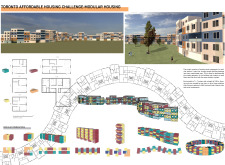5 key facts about this project
The project focuses on developing modular housing units to address the pressing need for affordable living spaces in urban areas, particularly in Toronto. The design concept revolves around a modular system that offers flexibility in housing configurations, catering to the diverse needs of families and social groups. By emphasizing a thoughtful arrangement of space, the aim is to create functional environments within a dense urban context.
Modular System Design
A modular approach serves as the foundation of the design. It starts with basic structural units that can be combined or altered to create more intricate architectural shapes. This method enables the breakdown of traditional building forms into more fluid designs. Each module measures 7 x 7 meters with a height of 3.50 meters, which establishes a consistent framework for building. This standardization helps shorten construction time.
Adaptability and Community Engagement
The units are designed for adaptability, allowing configurations that can include one to multiple modules. This variety makes it possible to accommodate different family sizes and lifestyles, contributing to a sense of community among residents. By enhancing the spatial layout, the design encourages interaction, making it conducive for people to connect with their neighbors. Social engagement is a focal point in the arrangement of the housing complex.
Potential for Sustainable Practices
Although specific materials are not mentioned in the presentation, the modular system suggests the possible use of prefabricated elements. Such an approach can streamline construction while lowering costs. Additionally, it may contribute to environmental sustainability by minimizing waste. This method aligns well with the goal of creating practical housing solutions that respond to the demands of modern urban living.
The organization of space allows for easy customization, enabling residents to create their preferred living configurations. This focus on adaptability and community connection reflects a commitment to designing environments that are in tune with the needs of their inhabitants and the evolving dynamics of urban life.



















































